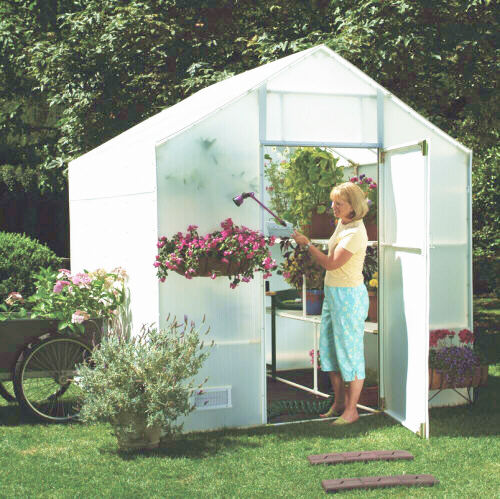It's Healthy To Vent - Greenhouse Ventilation is the Key to Success!

Owning a greenhouse means staving off the winter or getting a jump start on spring. But warmer spring days can be devastating in your greenhouse if you’re not prepared. Just one hot day may be all it takes to destroy your crop. Too much heat magnified in an enclosed space doesn’t make for an ideal environment, as the news of global warming reminds us nearly every day. We are used to hearing about greenhouse gasses and the ill effects of the trapped heat on our environment. Yet, greenhouses are designed to do just that- trap heat. The secret in staving off too much of a good thing lies in proper ventilation.
Ideally, a greenhouse will be insulated to hold in the heat. During the day the greenhouse warms with the sun’s rays and retains the solar energy through the night, protecting your plants from the chilly outside air. But an improperly vented greenhouse can be even more deadly. Just think of being locked inside a hot car - most plants can’t survive in an overheated environment.
Finding the balance between enough heat and too much can prove more difficult in the spring. The days are warm but nighttime temperatures still dip well below the growing range. There are several good ways to control temperature in a greenhouse, and one of the most important is proper ventilation. No greenhouse environment is healthy without it.
Proper ventilation not only cools a greenhouse, it also provides necessary fresh air. A lack of carbon dioxide is common in greenhouses that do not have a constant exchange of fresh air. Plants not getting enough CO2 often have leggy growth similar to that found with low light conditions. A temporary fix may be adding a small block of dry ice. This will provide some necessary CO2. However, it is only a temporary and costly measure that will not replace the fresh air provided by ventilation. Some measures may decrease the amount of ventilation needed, but there is no good substitute for fresh air.
Ventilation in a greenhouse is either manual or automatic. An automatic system will regulate heat, and humidity while providing the proper amount of fresh air. There is no need for constant monitoring. Automated systems are best for the most consistent year-round greenhouse temperature.
To set up your greenhouse with a more sophisticated means of ventilation, you will need to evaluate it to make sure the frame and the covering can support the weight of a built-in fan. Some frames can be modified to accommodate additional vents, while some will easily accommodate added vents and fans. The ideal placement for an exhaust fan is near the roof of the structure. Depending on the greenhouse design and construction, you may not be able to place a fan at the top, but you will want it as high as possible so the warmest air is removed. Some additional framing may be required to mount the fan. You will need to cut a hole in the covering for the blades. There is some evidence that mounting the fan over the door may help to deter bugs as well, however, that should not be the primary consideration. If bugs are an issue, a magnetic self-closing screen door is handy and easy to use.
The size of the fan you will need is dependent on the size of your greenhouse. Ventilation is measured by the number of air changes per hour. The minimum number of air changes in the warmer months should be one to one and one-half air changes per minute. The calculation for CFM (Cubic Feet per Minute) is: Length x Height x Width=Greenhouse Volume. Most companies that sell greenhouses have a calculator on their website to help you determine which size you need. For a larger greenhouse, two fans placed on the same end will be more effective than one large fan. In addition to exhaust fans, circulation fans will circulate the air in the greenhouse so that all areas receive fresh air. The air movement from the fans will aid in plant development as well.
Manual ventilation is the most ideal for cold frames. Manual venting draws cool air in from the base and vents the warm air from the top of the structure. Manual ventilation requires the least amount of equipment, is the least expensive, but requires the most monitoring. Simply adding a solar powered vent or louver opener can make manual vents more effective and efficient. Solar powered openers do not have a thermostat, but are somewhat adjustable. The primary chamber of the opener is filled with paraffin. Heat causes the paraffin to expand which puts pressure on the arm causing the lever to open. A small dial in the chamber changes the pressure thus adjusting the temperature required to move the arm.
 When using a solar opener, keep in mind that the temperature control is a range, not a specific temperature. A min/max thermometer is a must when using a solar powered opener. This thermometer will show a reading for the current temperature as well as the high and low. By checking and resetting the temperature daily you will be able to see what adjustments are needed to open or close the vents closer to the temperatures you wish to maintain. If you already have plants growing in your greenhouse, you may want to frequently check your greenhouse temperatures until you are satisfied that you have found the correct adjustment.
When using a solar opener, keep in mind that the temperature control is a range, not a specific temperature. A min/max thermometer is a must when using a solar powered opener. This thermometer will show a reading for the current temperature as well as the high and low. By checking and resetting the temperature daily you will be able to see what adjustments are needed to open or close the vents closer to the temperatures you wish to maintain. If you already have plants growing in your greenhouse, you may want to frequently check your greenhouse temperatures until you are satisfied that you have found the correct adjustment.
If relying on natural (manual) ventilation, it is important to consider other factors that can mitigate excess heat. Providing shading will significantly decrease temperatures. White washing was a common practice with glass greenhouses. White washing is a simple mixture of water and white latex paint applied directly to glass in spring. In the fall, the paint is tediously removed. Glass used to be the most common covering for a greenhouse but newer materials are less expensive, provide more insulation and are generally easier to maintain. White washing will either damage or will not stick to most of the greenhouse materials used today. Instead, the shade cloth is a good alternative to white washing, and it’s much easier.
Clear coverings will generate the most unwanted heat. A covering that diffuses the light eliminates or reduces excess heat and also decreases the burning rays in the greenhouse. The clearer the material, the more shade protection is needed. Most shade cloth is a black knit that is draped over the structure.
Newer materials, such as the Aluminet cloth, are made of Mylar. The reflective material will not trap the heat or catch the wind and can be left on all year if desired.
Whatever method you decide to use, with a little bit of planning you can have a healthy greenhouse all year. Don’t let the heat or your frustration build up. Your greenhouse is the perfect place to vent!






